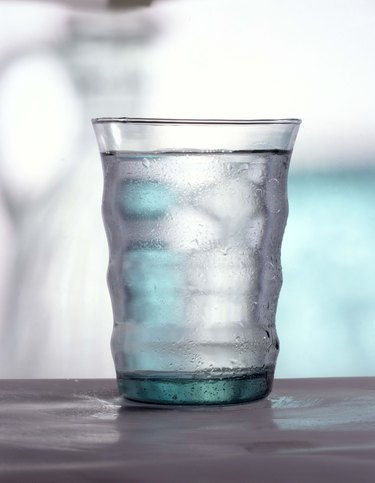
Condensation, or sweat, appears on walls and windows when water in the air, known as humidity, touches a surface that is cooler than the water temperature. Condensation on interior walls and windows usually occurs during the fall and spring, when temperature changes from day to night are larger, although it can happen any time. The warmer the air inside and the colder the air outside, the more sweat you will have on your walls and windows.
Condensation
Video of the Day
Condensation inside a home is normal. The tighter a window seal is, the more condensation you will see on the inside of the window if the inside air is moister and hotter than the outside air. Condensation between the panes of double paned windows, however, may indicate a poor seal between the windows and should be checked out by a window professional. Condensation will often form at the top of a window or wall where the air is warmer and drop or roll down the wall or window pane to the bottom.
Video of the Day
Dehumidifiers
Decrease the overall humidity in your home in order too decrease sweat on your walls or windows. This can usually be accomplished by a dehumidifier, an appliance that draws moisture out of the air and collects as water in a large bucket-like tray at the bottom of the machine. Dehumidifiers should be emptied as soon as they are full. Most dehumidifiers have an auto-stop feature that prevents them from collecting enough water to spill over onto a floor.
Increase ventilation
Another way to decrease humidity is to increase ventilation in a home. You can do this by running ceiling fans and exhaust fans in bathrooms, particularly after showering or bathing, and in the kitchen; making sure vents, like those from your clothes dryer, vent outdoors; by turning off any humidifiers in the house (sometimes furnaces have humidifiers attached that can be shut off); and by airing out the house several times a day when weather permits. Avoid leaving doors and windows open during wet weather, and leave wet clothes or umbrellas in an anteroom or even outside to prevent excess moisture from entering the house.
Condesation Ratings
If you are buying new windows or doors, you can check their condensation rating with the National Fenestration Rating Council, or NFRC. The NFRC puts labels on windows and doors that tell you determine the Condensation Resistance of any particular product on a scale of 1 to 100. The higher the number, the less condensation you will have on the inside of the door or window.